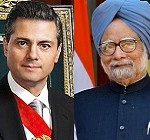Octavio Paz, the celebrated Mexican writer who was Ambassador to India in the sixties, wrote in his book “The Labyrinth of Solitude” that the “Mexican is always remote from the world and other people”. This was his conclusion after an in-depth analysis of the character and identity of the Mexicans, a mixture of Aztec and Mayan Indian traditions and European culture, in turn influenced overwhelmingly by the culture of the U.S.
If Paz were alive today, he would have changed the title or written another book titled “Network of Partnership” to reflect the new reality of Mexico.
The Mexicans are no longer alone in labyrinths introspecting on their solitude. They have become extroverts, eagerly embracing partnership and alliance with countries around the world. Mexico has signed Free Trade Area (FTA) agreements with 44 countries, which account for 70% of global GDP. Their FTA partners include the US, Canada, European Union, EFTA countries, Japan and Latin American countries. Mexico is a member of NAFTA, Pacific Alliance, APEC and OECD. It has joined the Trans Pacific Partnership (TPP) which is negotiating a new generation economic partnership among 12 countries, going beyond conventional FTAs.
With these, Mexico has expanded its economic and commercial space beyond its own market of 114 million people and GDP of $1.3 trillion. It has become a geographic, linguistic and cultural link to the markets of its partners, straddling the developed markets of the U.S. and Canada in the north and the emerging markets of South and Central America. The country has access to the east through the Atlantic and the west through the Pacific. It connects the northern entrepreneurship culture to the Latino spirit. As the largest Spanish-speaking country in the world, Mexico is the gateway to the larger market of 400 million Spanish speakers in Latin America, U.S. and Europe.
NAFTA has played a key role in Mexico’s competitiveness and external exposure, of course. But it is mostly the change in the Mexican mindset that has transformed the country. The recent rise of Mexican competitiveness has been concomitant with the rise of wages in China. According to a recent study by Bank of America, Mexican wages are 20% cheaper than China’s in some cases. Mexico has a large and growing youthful population unlike the aging Chinese society. U.S. imports from Mexico have increased more than those from China. It is, therefore, not surprising that Mexico is being talked of as the “China of the Americas”.
India can benefit from Mexico’s rise. Mexico is already India’s second largest economic partner in Latin America after Brazil, over which it has a competitive edge. The two largest Latin American markets of Brazil and Argentina have erected a number of barriers for imports, while the Mexican market is open, with low tariffs. Mexican government policies are stable, transparent, predictable and investor-friendly, quite different from the uncertain and bureaucratic policies of Argentina and Brazil. Inflation, cost of production, wages and interest in these competitors to Mexico are high – annual inflation in Argentina is 25% and companies are forced to increase wages by as much every year. This is in contrast with Mexico’s 3.6% inflation, and low wages ($2.50 per hour) and interest rates (4.8%). Not surprising then, that Mexico’s trade of $740 billion is larger than the combined total of Brazil and Argentina at $665 billion in 2012.
The Mexican market is going to be even more attractive in the future, given the ongoing reforms in various sectors of the economy under the “Mexico Pact”, a consensus agreement between the four major political parties of the country on vital national issues and reforms. For instance, legislation on telecom, and legal, education and tax reforms have already been passed. Energy reform is under discussion now.
With this reform easing the scope of business, and its network of geographical partnerships, Mexico is an attractive base for Indian companies with global strategies. Indian IT companies are already leveraging its unique position for their global delivery services. TCS has 3,000 developers in Mexico providing near-shore, same-time-zone services to its U.S. clients. The Mexican programmers develop software in English for the U.S. market and in Spanish for the Spanish-speaking market of 400 million. TCS finds value addition from the different mindset and culture of their Mexican managers and developers who complement the Indian imagination and creativity. Apart from IT companies, at least a dozen Indian companies use Mexico as a base for the manufacture of tyres, pharmaceuticals, chemicals and auto parts – mainly for exports to the Unites States. JK Tyres, for example, which has three plants employing 2000 Mexicans, also exports its Mexico-made products to Brazil.
Of course, Mexico faces many challenges – crime, drug trafficking, poverty, inequality and corruption. But what is important now is that Mexicans have a new mindset, confidence and optimism to tackle these issues.
It is time for the emerging Indian multinationals to look seriously at Mexico, and leverage its access to the NAFTA and EU markets and its competitive manufacturing. It is also time for the Indian government to take the initiative and sign a talked-of FTA with Mexico at the earliest, to eliminate the large tariff disadvantage faced by Indian exporters vis-a-vis those of the 44 countries which have FTAs with Mexico.
Ambassador Viswanathan is Distinguished Fellow, Latin America Studies, Gateway House. He is the former Indian Ambassador to Argentina, Uruguay, Paraguay and Venezuela, and Consul General in Sao Paulo.
This article was exclusively written for Gateway House: Indian Council on Global Relations. You can read more exclusive content here.
For interview requests with the author, or for permission to republish, please contact outreach@gatewayhouse.in.
© Copyright 2013 Gateway House: Indian Council on Global Relations. All rights reserved. Any unauthorized copying or reproduction is strictly prohibited.


